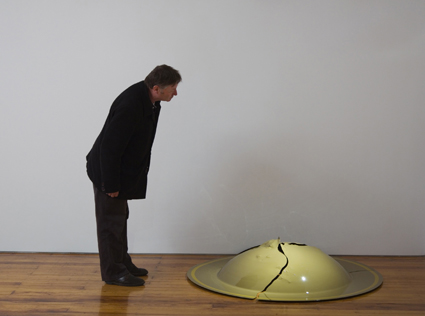teased by the trickster
sam gillies: sonia leber and david chesworth, space-shifter installation

Space-Shifter, Sonia Leber & David Chesworth
photo Christo Crocker, image courtesy the artists & Conical Gallery
Space-Shifter, Sonia Leber & David Chesworth
SPACE-SHIFTER, AN INSTALLATION BY SONIA LEBER AND DAVID CHESWORTH DIVORCES VOICE FROM CONVENTIONAL MEANING, ALLOWING VOCAL SOUNDS TO RUN FREE AROUND THE SPACE, COMPLETELY LIBERATED FROM CONTEXT. AN IMMERSIVE EXPERIENCE, SPACE-SHIFTER IS, AT BEST, AN EXAMPLE OF SOUND ART FUNCTIONING AS AN INTRICATE AND FULLY REALISED COMPOSITION.
At face value, the stark minimalism of the presentation means that you almost expect some sort of dry, scientific examination of psychoacoustic effects. Sound emitting objects—transducers attached to various sheets of metal—are grouped and oriented in fixed positions around the space. Thankfully, initial fears are laid to rest, as the sonic character of the work proves unique.
Various kinds of rattles and plate reverb-style thumps help to give the disembodied vocals a strong presence in the room. The use of the PICA performance space’s black box as the site for the work adds gravity to the sound, creating a darker and more theatrical take on the antagonistic ‘trickster’ running around the space—at times creating a real sense of paranoia.
The visual aesthetic is decidedly minimal. The use of dented, broken and warped pieces of painted metal gives the impression that we are in the aftermath of some kind of powerful event that has caused the voice to be dislodged from the body and left free to run amok. While the physicality of the installation is a strong element, the audience might not ponder its significance, so immediately visceral is the sound content of the work.
It’s difficult to characterise these sounds. Treated as acoustic objects in their own right, a collage of extended vocal techniques fills the space. Initially the sounds are off-putting because of their disembodied unfamiliarity. However, after a while the various sequences of vocal extensions—squeals, grunts, growls, hisses, and laughter—become somewhat normalised within the context of the space. While you never quite know what to expect, the audience is able to quickly tune into the work’s lexicon and anticipate the kind of sound that could occur.
The spatialisation of this work is a real achievement. The distance between the sound emitting transducers is perfect and the dampened acoustic space of the PICA performance space creates a precise embodiment for the sound. It’s an immensely immersive listening experience as sounds bounce around, up walls and over the audience’s head.
But there is more to this work than just strange spatialisation. There is a real sense of composition, of arc and development over the duration of the 15-minute work. Dynamic variation is key to creating lasting interest in a piece such as this and is not neglected. Sound intensities rise and fall at rates that seem to be a little bit less than what the audience expects at any given time, adding yet another ‘trickster’ element to the work as it craftily eludes your expectations. With no obvious beginning or end, the constantly changing interaction between sound elements seems to allow the audience to derive a form from the work that is based upon their own experience of the space: a great achievement.






